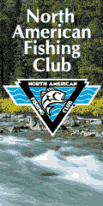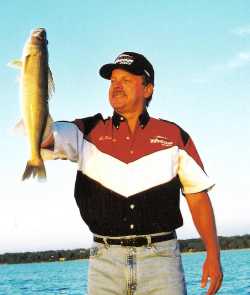
|
|||
|
Promotional Team Favorites Lodging food and more 
|
By JOHN KOLINSKI Editor's note: John Kolinski is the reigning Professional Walleye Trail
It's a warm spring day, and the walleyes are biting on the major bodies
of
in the larger size slots. In most of these small bodies of water, there is limited natural reproduction and relatively low overall numbers, but tremendous quality in the population that exists. Other clues can be found in a lake's average depth (18 to 20 feet is usually necessary in the upper Midwest), the forage base (minnow species are a must) and the substrate (areas of sand, gravel and rock are good). In some cases, there is no reproduction and the walleyes that live there make up what is known as a "remnant" population of survivors from stockings at one time or another. The best way to find out exactly what a small lake has to offer is to experience it. When I first launch on a new body of water, I rely on my Lowrance X-19 to paint a picture of what I'm dealing with. Spending half an hour exploring the lake and marking ledges, humps and other structure on your GPS is time well-invested. Pick your fishing spots carefully. With limited numbers of walleyes available, spring can be the most revealing time of year because they are gathered in predictable post-spawn locations such as shallow, stained water. Whether they drop eggs or not, their natural instincts lead them to behave as would any other walleye, and this time of year that means some serious foraging. If it's a clear-water lake, concentrate your efforts during the early and late low-light periods of the day or at night when the fish are most likely to be active. In stained water, it's a good strategy to fish shallow early and late and concentrate on slightly deeper structure during midday periods. Small lakes are often wind-driven. That means if the wind is blowing into a certain shoreline or a certain rockpile or sandbar, that's where you want to focus your efforts. On shoreline structure, try casting minnow-, leech- or crawler-tipped Lindy Techni-Glo Fuzz-E Grubs on top of ledges where walleyes will feed during windy conditions. If there aren't any defined edges available, casting crankbaits such as Shad Raps or Thunder Cranks is a good option that helps an angler cover potential water quickly. When I'm pitching jigs in shallow, stained water, I like the sensitivity and quick hook-setting reaction I get by using Berkley Fireline on a Berkley Series One spinning rod. When casting cranks, I prefer a monofilament such as Berkley's 8-pound Vanish or Trilene XL. If I can identify what appears to be a mid-lake rockpile, I like to anchor my Triton 205 and try a variety of methods from casting jigs and cranks to slip-bobbering with live bait. One of the most effective methods I've found on small bodies of water is drifting live bait on Lindy Rigs along the edges of wind-blown structure. Tail-hooked redtail chubs can be dynamite when they are available, and you can always tell when a walleye is closing in by the increased activity the chub exhibits. Leeches and crawlers are equally effective at times. Once you have established the presence of a walleye population, these small, close-to-home lakes are also ideal grounds for experimenting with new baits, new techniques and new presentations. If I drive a long way to get to a fishing spot, I want to make the most efficient use of the time I have on the water. It follows that I'm not as likely to stray from proven methods. There aren't many secrets left in walleye fishing, and those who enjoy a good bite on a small lake should strive to protect it. Release the majority of those fish to fight again another day. After all, you will probably be the only one who knows they are there. E-mail John Kolinski Fish Clix Banner Exchange Please visit these site sponsors |
||
|---|---|---|---|
